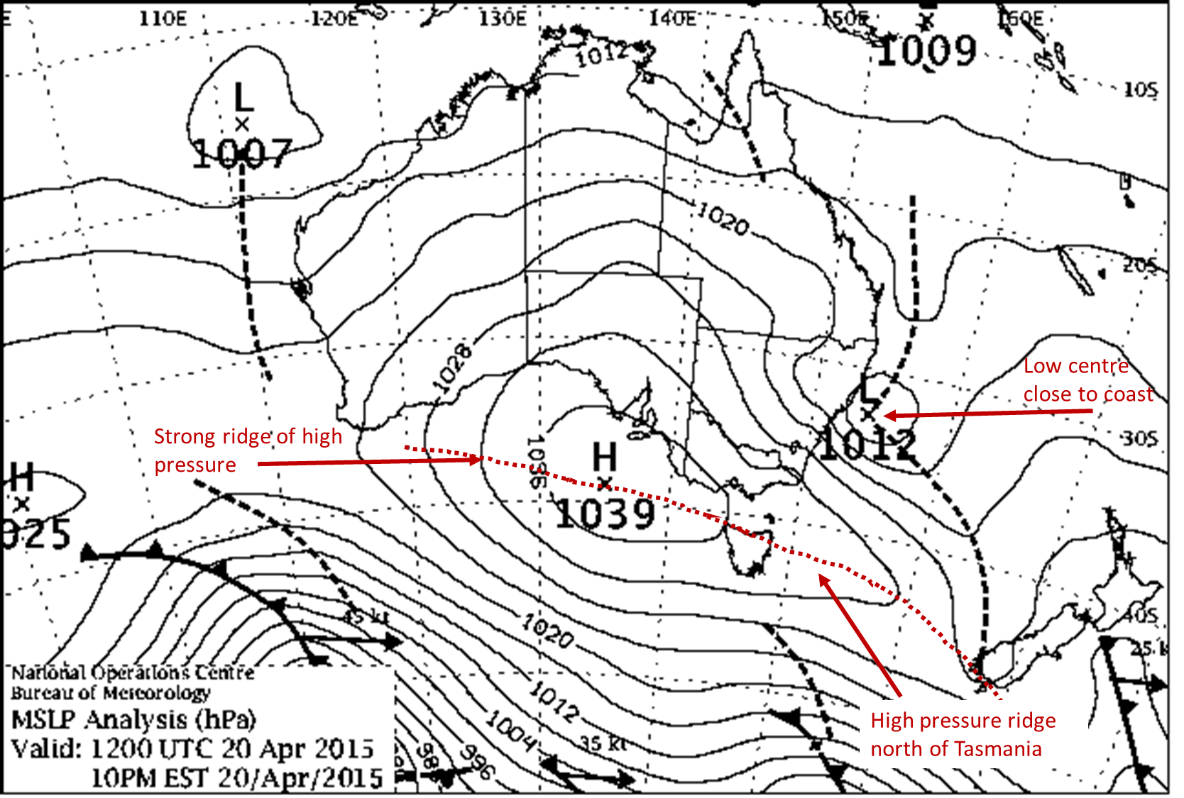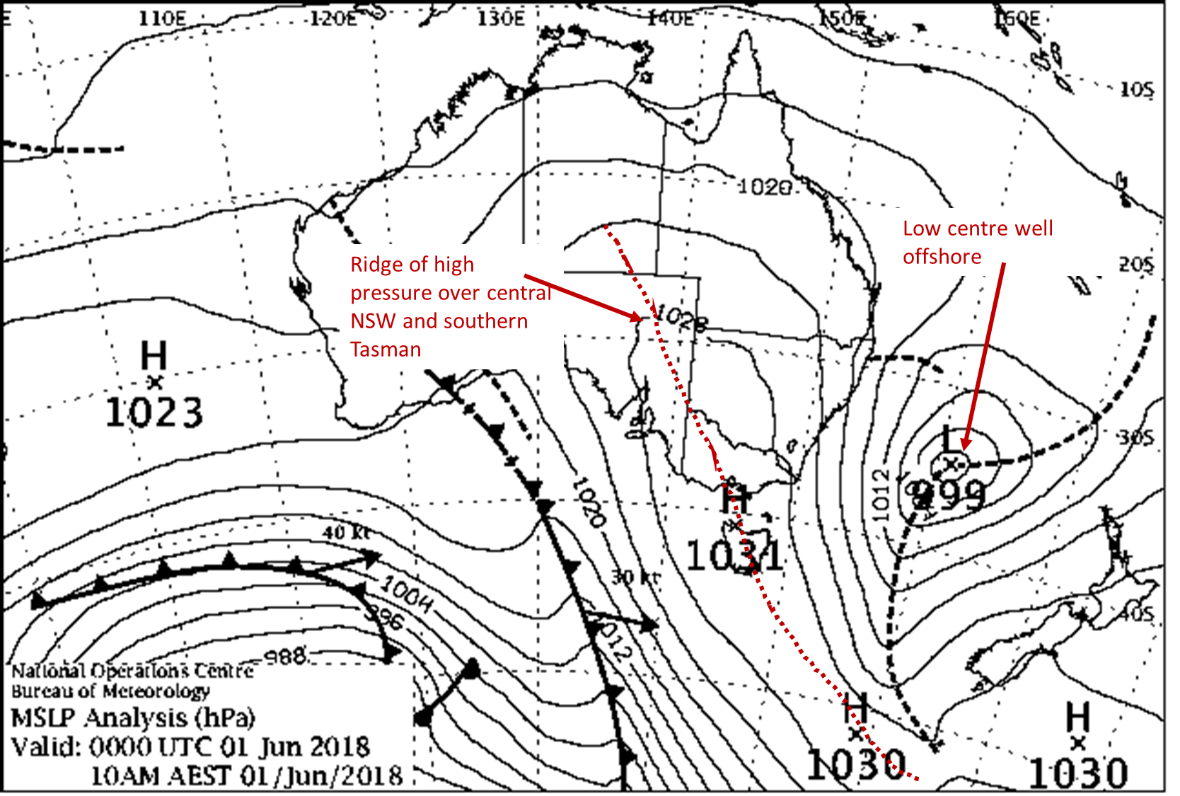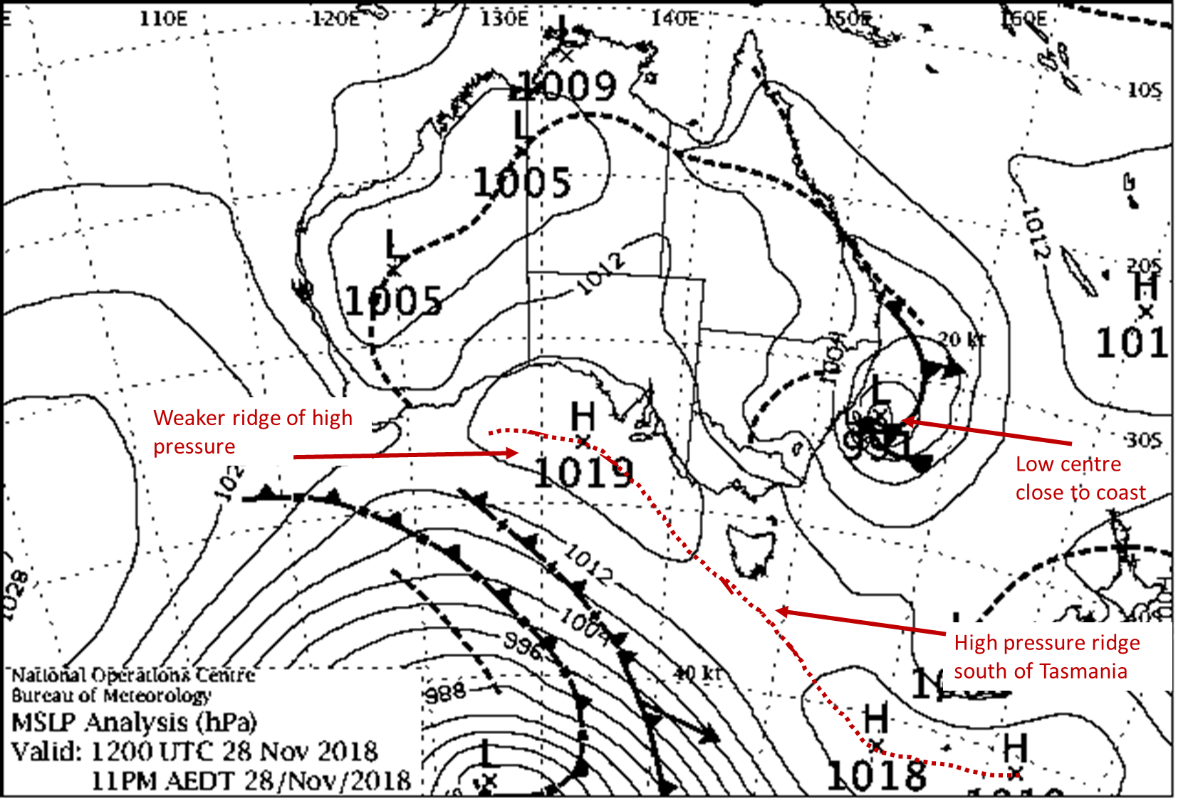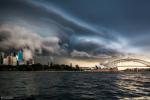Know your lows: East Coast Lows (and lookalikes)
22 May 2019
An East Coast Low is an intense low pressure system that causes severe weather over much of Australia's eastern seaboard, and the Tasman and Coral seas. These systems hog the headlines, but where strong low pressure systems in the east are concerned, they're far from the only game in town. So, what exactly is an East Coast Low—and what else is out there?
What is an East Coast Low?
On the ground an East Coast Low can generate very strong winds, heavy rain leading to flooding, and rough seas and heavy swells that can cause coastal erosion and inundation. So, how do we recognise a low as an East Coast Low? A basic definition is a low pressure system that:
- is a 'closed' system (has a central lowest pressure that is surrounded by higher pressure);
- forms between 20°S and 40°S (latitude) along the eastern Australian coast;
- lingers within around 200 km of the coast for at least 12 hours;
- has a pressure gradient of 4 hPa/100 km (meaning that the pressure drops by at least 4 hectopascals as we move 100 km towards the centre of the low) and/or is an intense cyclonic system (one that is generating very fast winds turning in a clockwise direction); and
- is associated with severe weather (such as damaging winds, heavy rain and dangerous seas).
However, this doesn't capture the full nature of these lows, because these characteristics look only at the surface of the atmosphere.
East Coast Lows become such intense systems largely due to interactions between the surface of the atmosphere, the upper atmosphere and the top layers of the ocean. These factors determine not just how intense the low is, but also where it develops and how long it lingers there (both of which have a big bearing on the impacts we see).
Video: Watch this short video explaining East Coast Lows.
An East Coast Low forms when a strong 'upper disturbance' moves near the eastern coastline. This is like a wave in the top levels of the atmosphere (around 10–15 km above the ground). As it moves towards the coast, it causes the development of another wave (in this case, a low pressure trough or system) in the low levels of the atmosphere on its eastern flank. When this surface low moves over the coast, the temperature difference (or gradient) between the warmer water and cooler land (or warm water with a cooler water mass) can cause rapid development of the low. This means that the pressure gradient of the low increases, which in turn causing a strengthening of the winds.
Another key ingredient for an East Coast Low is a 'cradling high'. This means a high pressure system in the southern Tasman Sea, which blocks the East Coast Low from moving away from the coast, making it a much more long-lived and significant system. The high also creates a stronger pressure gradient along the southern side of the low, causing stronger winds.

Chart: East Coast Low, 20 April 2015. During 20–22 April an intense East Coast Low affected highly populated areas of the central NSW coastline, including the Sydney and Hunter regions. Over a 48-hour period very heavy rain, gale-force winds, and damaging surf battered the coast between Nowra and Seal Rocks.
East Coast Low 'lookalikes'
So, when is a bad-weather-bringing low not an East Coast Low? There are a number of systems over the east coast that can (at first glance on a weather map (MSLP chart) look very similar to an East Coast Low, but have very different structures and impacts. Four of the most common lookalikes are listed below, along with charts showing the key differences from an East Coast Low.
Ex-tropical cyclones
Tropical cyclones usually originate north of 20oS, and require tropical sea surface temperatures to develop. This gives them a unique structure and behaviour, which is very different from an East Coast Low. As a cyclone drifts south, it starts to lose this structure, but can still cause very dangerous weather with significant impacts such as intense rainfall, extensive flooding and destructive winds—similar to an East Coast Low. Sometimes an ex-tropical cyclone can transition into an East Coast Low (if some or most of the above conditions are present).

Chart: Ex-tropical cyclone Debbie, 30 March 2017. During the multi-day impact of ex-tropical cyclone Debbie, northern parts of the Northern Rivers district saw rainfall totals in excess of 400 mm. In the Tweed, Brunswick and Wilsons river valleys, numerous locations received more than 450 mm. This caused widespread overland flooding, large losses to crops, property and infrastructure and several lives were lost.
Offshore lows
If an intense low pressure system lies further from the coast than around 200 km, we usually call it an offshore (or Tasman) low. Most often, the impacts of a low pressure system are felt closer to the centre of the low. Because the centres of these systems are much further away from the mainland they can't create the damaging winds or heavy rain along the coast that we usually see with an East Coast Low. They can, however, still cause damaging surf and be very dangerous for boating and other marine activities. They can also cause damage to property and coastal erosion, particularly around high tide, when the water is already closer to houses and buildings.

Chart: Tasman Low, 1 June 2018. Showers moved over coastal NSW during the early days of June, with 1–10 mm over most of the coast and up to 30–40 mm in the Hunter region on 2 June. Persistent strong southerly winds, up to gale force in exposed coastal locations, and large swell were also apparent along the coast.
Coastal troughs
Sometimes a low pressure trough develops or moves very close to the coast—we call this a coastal trough. These troughs don't have the structure of an East Coast Low in that they don't have a single closed circulation. Because of this, their impact is usually less than that of an East Coast Low. However, small lows can develop within these troughs, delivering more localised, small-scale heavy rainfall and/or damaging winds.

Chart: Coastal trough, 4 December 2017. Moderate to heavy showers affected coastal NSW, with 40–90 mm recorded along parts of the southern coastal fringe.
Transient lows
Lows can also develop very close to the coast, but move away before they have time to cause widespread damage. We usually call these transient lows. They don't linger along the coast the way an East Coast Low would. They normally develop over land and intensify rapidly on the coast, before moving off to the east. While transient lows can cause severe weather, it doesn't tend to be as prolonged or intense as with a more developed and slow-moving East Coast Low.

Chart: Transient low, 28 November 2018. During 27–28 November, a transient low delivered around 50–100 mm of rain about central parts of the coast and adjacent with some locations around the Blue Mountains, Southern Highlands and Shoalhaven seeing totals between 150–222 mm.
Predicting what kind of low will develop
There are often signs of a developing East Coast Low up to a week ahead of its impact, but whether it will cause severe weather is usually very difficult to determine until it is much closer. Looking for intensification factors, such as a strong upper disturbance moving towards the coast; a strong, lingering, high pressure system in the southern Tasman Sea and large sea surface temperature gradients near the coast can give us a better understanding of how a low pressure system will develop, how long it will remain near the coast and how severe it will become.
How will I know if severe weather is on the way?
The Bureau works closely with emergency services to ensure that people are prepared for the dangerous weather associated with East Coast Lows and other lows. Over land areas, we use Severe Weather Warnings to warn of the dangerous winds, damaging surf, abnormally high tides that can cause coastal erosion, and heavy rain leading to flash flooding that an East Coast Low or other low can bring. If needed, we also issue Flood Warnings to warn of river flooding, and Severe Thunderstorm Warnings. Over the sea we use the standard Marine Wind Warnings to alert people about hazardous conditions.
Always check our website for the latest warnings and listen to advice from emergency services.
More information
Top left (small) image credit: Shelf cloud over Sydney on 25 April 2015 during an ECL event, by Daniel Tran Photography.




Comment. Tell us what you think of this article.
Share. Tell others.